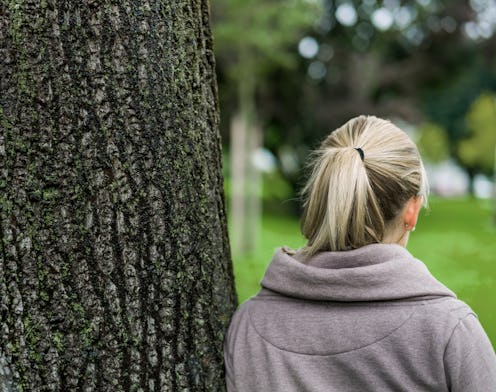Life
Spring SAD Is A Thing & Here’s What Experts Want You To Know

Seasonal depression or seasonal affective disorder (SAD) is most commonly associated with the winter, but the truth is it’s not just those dark winter days that can affect your mental health. You might expect your depression to start to lift with the warmer temps and melting snow, but sometimes seasonal change itself can impact your mental health — even if the days are getting longer. If that’s the case, there’s a chance you might be experiencing spring SAD, the springtime version of seasonal affective disorder.
Seasonal affective disorder affects about 10 million Americans every year, but it is four times more common in women than men, according to Psychology Today. Neda Gould, PhD, director of the Mindfulness Program at Johns Hopkins Medicine and associate director at the Bayview Anxiety Disorders Clinic, tells Bustle that spring SAD is less common than winter SAD, affecting about four to six percent of the U.S. population.
Gould says the underlying cause of spring SAD isn’t fully understood and is different for each person, but like other forms of depression, both biology and environment most likely play a role. “Someone may have a genetic vulnerability to depression and the changes that come with spring/summer, [like the] lack of structure, changes in schedule, and heat could contribute to the onset of summer SAD,” Gould tells Bustle.
But sometimes just being surrounded by happy-looking people who are enjoying the warmer spring weather can be enough to trigger depressive symptoms, Celeste Viciere, licensed mental health counselor and host of the Celeste the Therapist Podcast, tells Bustle. “Some people with SAD struggle in the springtime […] because they are now surrounded by so many people who appear to be happy and enjoying themselves,” says Viciere. “Looking at someone else's external appearance and comparing it to your internal struggle can leave you in a depressive state.”
It’s important to note that seasonal depression isn’t as simple as how much sunlight you’re getting, Mayo Clinic psychologist Craig Sawchuk, PhD, LP, tells Bustle. When it comes to finding relief from spring SAD or any seasonal depression, Sawchuk says, “Sunlight is still a good thing, but typically we want to emphasize additional factors, such as maintaining a normal daily routine, [such as] the sleep-wake cycle, regular nutrition, social rhythms, getting physical activity and exercise, [because] seasonal changes in mood are often associated with fatigue [and] the tendency to want to sleep, staying connected with social supports, and making plans to increase the frequency of engaging in meaningful activities across a given week. These are typically viewed as ‘natural antidepressants.’”
Gould tells Bustle the signs of seasonal depression are the same as other forms of depression: difficulty sleeping, anxiety, and poor appetite. The Anxiety and Depression Association of America says other signs of depression might include persistent feelings of hopelessness, guilt, feelings of worthlessness, loss of interest in hobbies or activities, difficulty concentrating or remembering things, and thoughts of death or suicide. You’ll know if your depression is on a seasonal pattern if you see the same peak and decline in symptoms during the same time frames for at least two years, Sawchuk tells Bustle.
If natural antidepressants aren’t helping, Sawchuk says you can talk to your doctor about other options, like antidepressants or cognitive behavioral therapy. Your mental health journey is an individual process — just know there’s help out there if you need it.
If you or someone you know is seeking help for mental health concerns, visit the National Alliance on Mental Health (NAMI) website, or call 1-800-950-NAMI(6264). For confidential treatment referrals, visit the Substance Abuse and Mental Health Services Administration (SAMHSA) website, or call the National Helpline at 1-800-662-HELP(4357). In an emergency, contact the National Suicide Prevention Lifeline at 1-800-273-TALK(8255) or call 911.